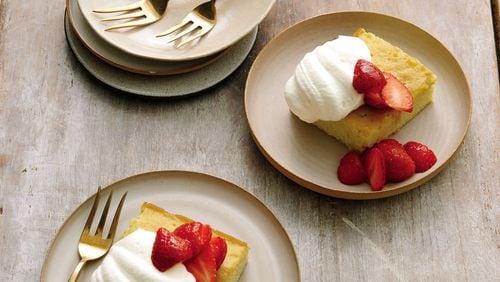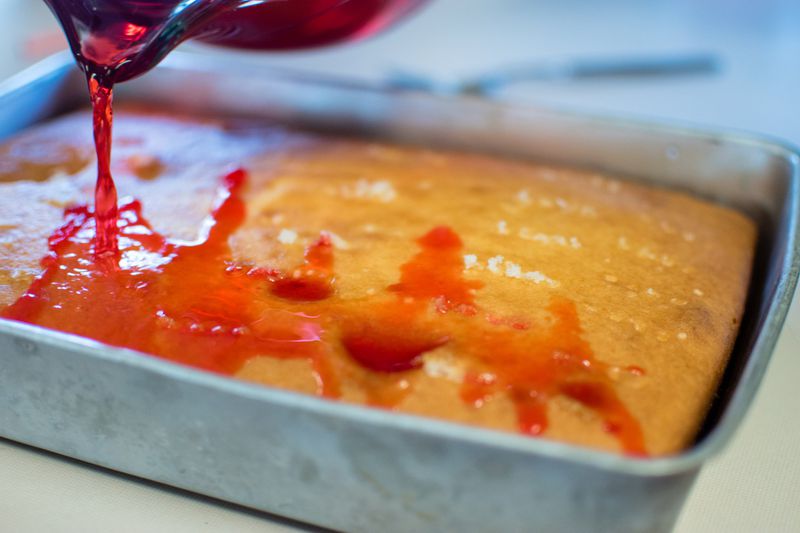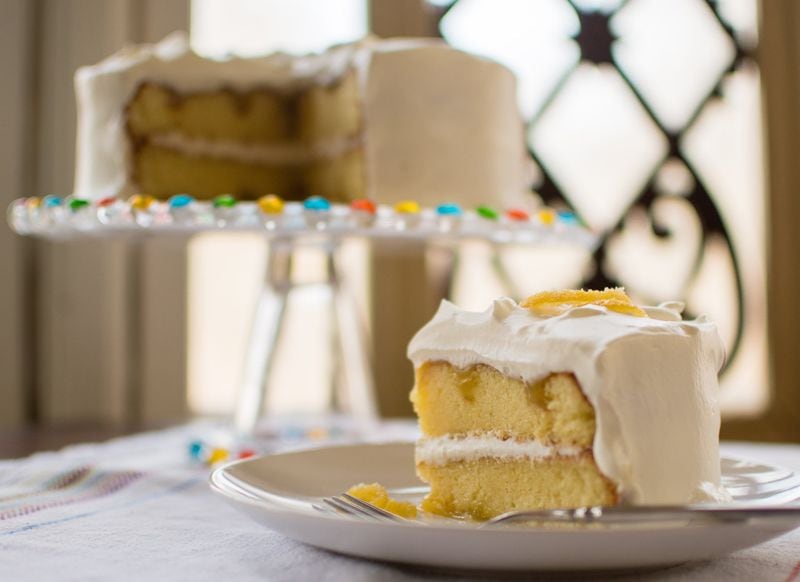In the pantheon of American cakes, poke cake hardly seems poised to stand on the podium for gold, silver or even bronze. Surely those accolades would go to something more dignified, such as chocolate cake, or Lane cake; possibly Boston cream pie?
Simply, and somewhat crudely, titled, the cake is an advertising invention of the late 1970s, when Jell-O used it to re-initiate the public to its jiggly, ubiquitous resourcefulness in dessert making. Jell-O salads of the 50s and 60s were outmoded and on the wane; the poke cake was a way to bring Jell-O back.
RELATED: What is hummingbird cake?
According to Lynne Galia of the Kraft Heinz Company, the Jell-O gelatin poke cake, developed by General Foods Kitchens, first appeared in print advertising and in Jell-O recipe booklets in 1976. The subsequent Jell-O pudding poke cake recipe was introduced in 1981. It’s also, according to Galia, “one of the most requested Jell-O recipes.”
“The cake’s colorfulness has an almost tie dye affect,” said Anne Byrn, author of “The Cake Mix Doctor” series of cookbooks, and most recently, “American Cake” (Rodale, September 2017, $29.99). “It’s not surprising it would be a hit in the 70s. It’s brilliant marketing for the Jell-O brand.”
Beyond the appeal of its retro bright colors, the cake is almost foolproof to make – it uses a cake mix, liquid Jell-O and, originally, Cool Whip as the topping. After baking, the cake is “poked” with a fork, and the liquid Jell-O is poured over to seep into and under the cake’s surface – creating bright stripes of color.
It was easy, fast, and passed muster as a sweet third course for a mom who, in addition to homemaking in 1976, might have just entered the workforce.
"Sopping a cake with a syrup is hardly a novel idea, though," Byrn explained. "The French genoise is almost always brushed with a flavored syrup to moisten and flavor. And tres leches cake, which is soaked in three milks (evaporated, sweetened condensed and whole milk), has been around since the 19th century."
Indeed. European trifles – including tiramisu – seem lofty now, but they defy their humble medieval origins, and are certainly the antecedents to poke cakes. “Sopping the cake was an easy way to use old or stale cake, in the same way bread puddings used old bread,” said Byrn. “Nothing was wasted. Old cake was turned into something new.”
Tres leches’ rise in popularity may be due to the proliferation of canned milk across much of Central and South America for lack of refrigeration. And like the Jell-O poke cake, it was an advertising ploy.
In a 2004 article for the Austin Chronicle, writer MM Pack notes, “The most obvious source for disseminating the (tres leches) recipe had to be the manufacturers of evaporated and condensed milk … Nestlé (a major canned milk producer since 1875) established manufacturing plants in Mexico right around World War II. According to Nestlé brand manager Nancy Lopez-Pedrosa, the company has routinely published recipes on the can labels.”
Another poke cake that has risen to near legendary status, but without an advertising campaign: Sticky Toffee Pudding. British – or perhaps Canadian (no source seems to really know) – in origin, the first recipe for this delicious throwback to the sopped cakes of medieval times, according to British food writer and critic Simon Hopkinson, is from “The Good Food Guide Dinner Party Book” (published by the Consumers’ Association and Hodder & Stoughton in 1971).” The cake is attributed to Mrs. Martin from The Old Rectory, Claughton, Lancashire. According to Hopkinson, Mrs. Martin claims to have gotten the idea for the cake from two Canadian soldiers who stayed at the inn during World War II.
The Sharrow Inn in Cumbria claims otherwise, noting on its Website, “The original Sticky Toffee Pudding recipe was created by Francis Coulson at Sharrow Bay in the 1970s … Francis Coulson’s original, secret recipe is the stuff of culinary legend, anecdotally inspired by Brian Sack’s time as an RAF Spitfire pilot, where he saw Canadian RAF Pilots use maple syrup.”
No matter the origin, the date-studded, toffee cake-pudding is a modern classic, easily as ubiquitous as tres leches, and like the latter, made its way onto countless dessert menus over the past 25 years.
The original recipe for Jell-O poke cake was raspberry, but the most requested flavor, according to Galia, is strawberry. It’s fun, light and sweet, perfect with a simple chantilly cream as topping, or Cool Whip, if you want to go totally 70s. Because poke cake is clearly not just old school, it’s practically ancient. A little bit of history between the tines of a fork.
Original Strawberry Jell-O Poke Cake
This recipe comes from the Kraft Heinz Website. According to Lynne Galia, the company spokesperson for corporate affairs, the recipe first appeared in print advertising in 1976. Raspberry was the original flavor, but use whatever Jell-O flavor suits. In our photos, we’ve substituted Chantilly Cream for Cool Whip (see recipe, below), and used orange and cherry flavors.
Yield: 16 servings
Lemon Poke Cake
This is one of the most popular versions of the poke cake, and perfect for winter-to-spring gatherings, since it uses the bright flavor of citrus.
Yield: 12 servings
Anne Byrn’s Tres Leches Cake
This moist and delicious classic comes from Anne Byrn’s “American Cake.”
Byrn notes in her cookbook that “Three milks — whole milk, evaporated milk, and sweetened condensed milk — that is spooned onto a baked butter or sponge cake, pastel de tres leches has been a fixture in Mexican, Nicaraguan and Cuban kitchens for two generations. Texas Monthly writer Patricia Sharpe surmised in 1999 that the cake was so well-known it might have originated as a promotional recipe by a canned milk manufacturer. Sure enough, in the 1940s Nestlé opened an evaporated milk manufacturing plant in Mexico, and a recipe for this cake was on the label of those cans.
“But MM Pack, who discovered the Nestlé and Mexico connection, says the cake is even older and originated in Europe, where old Portuguese and Spanish desserts were often sponge cake soaked in egg cream. No doubt the popularity of Tres Leches in America has much to do with our country’s increasing Hispanic population. Now Tres Leches Cake and its myriad variations are found in homes, bakeries, and restaurants across the country. Baked large enough to feed a party or made smaller and individual like cupcakes, the Tres Leches is a blank canvas. Top it with whipped cream or meringue, sliced fresh fruit, or flavor it with caramel, rum, chocolate, or coconut.”
Makes: 12 to 16 servings
About the Author








